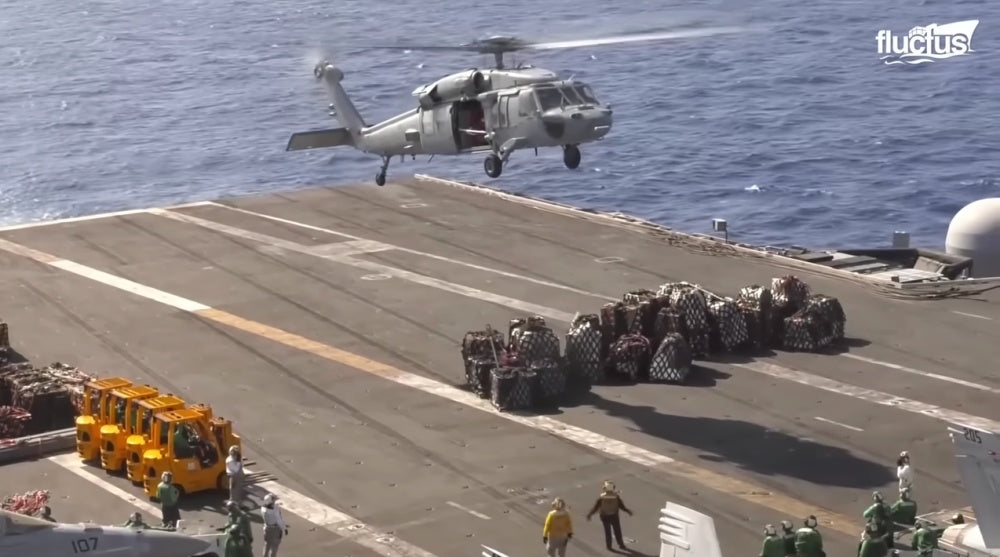Underway Replenishment At Sea: UNWREP
Dan Doyle
This story is about basic needs, that is, how to resupply Navy ships at sea with the basic needs that are necessary for a ship at sea to be able to stay on mission without having to go to port.
It is probably true that most of us have never given a thought to the matter of ship resupply, having never served on a U.S. Navy warship. But it must be done, and since WWII, the Navy has been developing the means to do this critical mission in ways that can keep warships on station or on mission without the need to return to some port. Having to go back to port creates readiness and safety issues. Such a necessity would take a ship off the line and would make both the ship and the port vulnerable to attack. But a warship at sea uses up material supplies, food, fuel, and ammunition that must be replenished in order for it to stay on the mission.
 Photo: YouTube/Fluctus
Photo: YouTube/FluctusThis video will show several ways the Navy has developed to accomplish this important task. The first means was developed first during WWII. Specialized cargo/supply ships have been developed to bring the goods to a warship that is underway at sea. The technique is like a very sophisticated and coordinated dance, considering the fact that both ships are still underway. They are moving in open waters and can be affected by the condition of the sea.
You'll see how the two ships come up aside each other and how the sailors aboard make the necessary connections to begin passing tons of supplies and fuel from the cargo resupply ships to the warships. The techniques used today are safer and more reliable than back in WWII due to advanced technologies, which makes this difficult action safer as well.
 Photo: YouTube/Fluctus
Photo: YouTube/FluctusYou'll see that, depending on the distance between the ships and the condition of the seas, a line is passed between ships by a fire line gun, which a sailor, using what looks like a modified M-1 Garrand or an M-14, fires a line over to the supply ship. Or, if the ships are close enough, a sailor with a good throwing arm can toss the line to the other ship. This line is then used to draw the heavier supply transfer lines to be hooked up to pulley systems in order to begin the supply transfers or to bring the fuel lines over to the ship being resupplied and begin refueling.
It is a fascinating, coordinated process and involves a great deal of work on both ships. The supplies have to be gathered and transferred from the supply ship, and the sailors on the ships being resupplied coordinate the reception of the supplies and then move them to the various parts of the ship where they belong.
 Photo: YouTube/Fluctus
Photo: YouTube/FluctusThere are greater safety issues involved, of course, with the refueling process. Fuel is by its nature more volatile, and care must be taken throughout the refueling process to prevent fires. If fuel is ignited, it could spread from ship to ship very rapidly, and keeping the refueling lines out of the water is important in this process. You will see what I mean as you watch the video.
Other forms of resupply at sea are also dealt with. For example, if sea conditions make it necessary, aerial resupply using helicopters can be an alternative means of resupplying a ship at sea. You get a sense of how this is done in the video as well.
 Photo: YouTube/Fluctus
Photo: YouTube/FluctusThe method that was most interesting to me was how huge C-17 Globemasters are used to airdrop supplies to submarines. These missions have to be coordinated very precisely in order to prevent the submarines from being vulnerable on the surface. The Globemasters then parachute the supplies to the sea surface near the submarine, which is aided by a smaller surface craft to retrieve the air-dropped supplies.
I think you will find this at-sea resupply information very fascinating. It gives you a new perspective on what life aboard a modern Navy ship is like today. You even see toward the end of the video how something as common as mail delivery is accomplished aboard a ship on a regular basis. They can even make and receive orders from Amazon these days.
 Photo: YouTube/Fluctus
Photo: YouTube/FluctusEnjoy this very interesting look into how life aboard ship is maintained at sea. It is amazing to see how the complexities of modern life are adapted and handled in today's Navy. We wish all those sailors who serve aboard the Navy's resupply ships and those who serve aboard her warships "Fair Winds And Following Seas."
https://www.youtube.com/watch?v=mdlXHr9hJfI&feature=youtu.be

Dan Doyle is a husband, father, grandfather, Vietnam veteran, and retired professor of Humanities at Seattle University. He taught 13 years at the high school level and 22 years at the university level. He spends his time now babysitting his granddaughter. He is a poet and a blogger as well. Dan holds an AA degree in English Literature, a BA in Comparative Literature, and an MA in Theology, and writes regularly for The Veterans Site Blog.




















